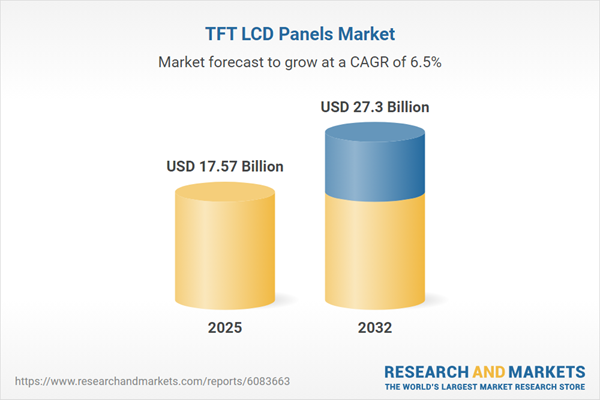Speak directly to the analyst to clarify any post sales queries you may have.
The TFT LCD Panels Market is experiencing substantial shifts driven by advanced display technologies, evolving supply chains, and changing end-user needs. For senior decision-makers navigating these changes, understanding the core trends and dynamics is essential for shaping procurement, technology investment, and market competitiveness.
Market Snapshot: TFT LCD Panels Market Overview
The TFT LCD Panels Market advanced from USD 16.50 billion in 2024 to USD 17.57 billion in 2025 and is projected to achieve a 6.49% CAGR, reaching USD 27.30 billion by 2032.
Scope & Segmentation
This report offers a comprehensive analysis of the TFT LCD Panels Market, focusing on actionable insights for strategic planning and informed investment. In-depth segmentation highlights key market areas for precise decision-making:
- Application: Examines use in industrial displays, gaming and standard monitors, notebooks, smartphones, tablets, and both smart and standard televisions. Each segment reflects unique market demands and growth drivers.
- Panel Size: Details categories from below 7 inches to above 32 inches, supporting integration across varied device classes.
- Resolution: Discusses HD, Full HD, Quad HD, and Ultra HD, illustrating how resolution advances address application-specific clarity needs.
- Panel Type: Reviews technologies including In-Plane Switching, Twisted Nematic, and Vertical Alignment, each offering distinct performance benefits.
- Color Depth: Analyses configurations from six bit to ten bit and above, catering to sector-specific graphic requirements.
- Refresh Rate: Covers sixty and one hundred twenty hertz, reflecting end-user priorities for performance across entertainment and productivity solutions.
- Touch Integration: Considers both integrated and non-integrated designs, aligning with interactivity and usability trends.
- End User: Identifies key industries including automotive, consumer electronics, healthcare, and industrial sectors, each influencing technology adoption paths.
- Region: Assesses the Americas (featuring country-level details), Europe, Middle East & Africa, and Asia-Pacific, supplying regional context to guide localized decisions.
- Key Companies: Features analysis of BOE Technology Group Co., Ltd.; LG Display Co., Ltd.; Samsung Display Co., Ltd.; Shenzhen China Star Optoelectronics Technology Co., Ltd.; AU Optronics Corporation; Innolux Corporation; Sharp Corporation; Japan Display Inc.; Tianma Microelectronics Co., Ltd.; HannStar Display Corporation, outlining their strategic approaches and market positioning.
Key Takeaways: Strategic Insights for Decision-Makers
- Thin-film transistor LCD technology supports a broad range of applications, from consumer electronics to specialized sectors such as industrial automation and automotive interfaces.
- Manufacturers prioritize advancements in image clarity, energy savings, and seamless integration of touch and haptic feedback, responding to demands for efficiency and user experience.
- Product differentiation hinges on customizable features like panel size and color depth, enabling targeted value propositions in gaming, healthcare, and industrial markets.
- Regional market approaches vary: North America focuses on tailored solutions, EMEA values reliability for regulated settings, while Asia-Pacific drives scalable R&D and production.
- Top firms increasingly form partnerships and engage in collaborative innovation to meet compliance requirements, address sustainability priorities, and respond to evolving customer needs.
- Tiered offerings enable suppliers to serve diverse market segments, adapting product lines to evolving regulatory and demand conditions.
Tariff Impact: Adjusting Cost Structures and Supply Chains
The introduction of tariffs in 2025 prompted firms to reevaluate sourcing and manufacturing. Key responses include increased regionalization of supply chains, expanded local partnerships, and accelerated investment in domestic production. These strategies aim to manage risk and enhance supply chain resilience, critical for maintaining competitiveness amid policy shifts.
Technological Advances Driving Market Shifts
New developments, such as mini-LED backlighting, advanced driver ICs, and refined thin-film materials, are improving energy efficiency, image sharpness, and overall display capabilities. These enhancements are notably important for sectors requiring high reliability, such as automotive and healthcare, as well as for applications demanding improved interactivity and extended lifespan.
Segmentation and Regional Dynamics
Segment-focused strategies enable tailored solutions for sector-specific requirements. For example, medical and industrial applications require panels meeting rigorous quality and compliance standards, while regional approaches account for differing regulatory landscapes, technology adoption rates, and cost structures, optimizing market fit.
Methodology & Data Sources
This analysis combines in-depth secondary research from technical publications, industry reports, and policy documents with direct insights from executives and technical specialists. The methodology includes assessments of technology uptake, competitor mapping, and scenario modeling to validate findings and ensure actionable recommendations.
Why This Report Matters
- Enables senior leaders to benchmark organizational strategies and supplier relationships against the broader industry landscape within the TFT LCD Panels Market.
- Supports both capital and operational planning through timely intelligence on regulation, customer trends, and evolving policy frameworks.
- Clarifies how advances in technology, segmentation, and regional focus can be harnessed to inform product development and procurement decisions.
Conclusion
Participants in the TFT LCD sector must continuously adapt to technological progress, shifting regulations, and regional market dynamics. Informed strategies and forward-looking investment position organizations to capture emerging opportunities and reinforce their market posture.
Table of Contents
3. Executive Summary
4. Market Overview
7. Cumulative Impact of Artificial Intelligence 2025
Companies Mentioned
The companies profiled in this TFT LCD Panels market report include:- BOE Technology Group Co., Ltd.
- LG Display Co., Ltd.
- Samsung Display Co., Ltd.
- Shenzhen China Star Optoelectronics Technology Co., Ltd.
- AU Optronics Corporation
- Innolux Corporation
- Sharp Corporation
- Japan Display Inc.
- Tianma Microelectronics Co., Ltd.
- HannStar Display Corporation
Table Information
| Report Attribute | Details |
|---|---|
| No. of Pages | 188 |
| Published | November 2025 |
| Forecast Period | 2025 - 2032 |
| Estimated Market Value ( USD | $ 17.57 Billion |
| Forecasted Market Value ( USD | $ 27.3 Billion |
| Compound Annual Growth Rate | 6.4% |
| Regions Covered | Global |
| No. of Companies Mentioned | 11 |









